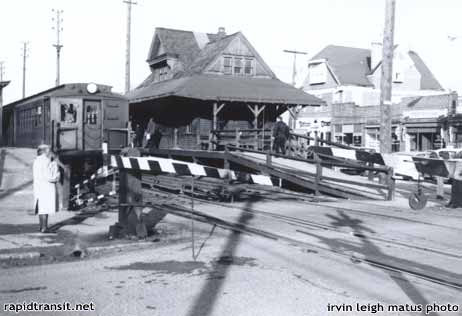
Page 10

The meeting of automobile roads and train tracks had become a source of concern. Most American railroads were, for the better part, on a level with the land surrounding them. Most still are. As a great deal of trackage runs through land that is rarely traveled, elaborate rights-of-way are not needed. The surface railroads where humankind was in greater abundance did not require, at the time the rails were laid, any alteration of the land for the few people who would cross it. "Stop, Look and Listen" became part of the American idiom.
The SIRT was, for much of the way, one such surface railroad. Early in the 20th century, an engine tooling down the Tottenville Line was shaken by a severe jolt.
The engineer looked out of his cab to see a side of beef flying by. Stopping the train he got out to find that he had done in an entire herd with the herdsman raising one of the first cries for grade-crossing elimination in Staten Island.
With the advent of automobiles the need became more pressing. When the 1920's produced a singularly carefree breed of youth, fond of racing with locomotives (as it was done in the movies), the damage to life, property and railroad schedules became acute. Many portions of the SIRT's three lines were raised to embankments or depressed in cuts, with the cottage style brick stationhouses replacing the old wooden ones
Smith may have feared that the SIRT, which was owned by the B&O, could afford its parent road entrance to the City. The reputed result of this calculation was "pressures" exerted by Smith to protect his interests. It should be noted that direct benefit to the B&O was doubtful unless that heavy rail carrier could have been linked to some other road -- such as the Long Island Railroad -- because it was certain that freight trains could not run in Brooklyn's subway tunnels, nor could standard railroad passenger cars make the tight curves.
It has also been said that the project simply ran out of funding; a likely but uninteresting conclusion.
Mishaps
In 1927 the railway was to be hit by a menace that was to recur twice more in the next 35 years, each time with devastating results. In that year fire claimed five of the brand new SIRT cars when it swept through the yard at Tottenville.
During the 1930's the SIRT underwent the first of a series of overhauls in the form of grade crossing elimination.

Unlike the subway system, where only a single grade crossing survived the early 1920s, the SIRT had many past World War II. Lasting until the final grade crossing elimination in 1965-'66 was this one at New Dorp station. The impressive station house, then badly vandalized, was saved and restored. It is now at the Richmondtown Restoration.
Updated
©1965 Silver Leaf Rapid Transit. ©2001 Paul Matus. ©2001 The Composing Stack Inc.